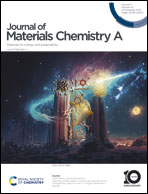An anthraquinone-based covalent organic framework for highly reversible aqueous zinc-ion battery cathodes†
Abstract
Aqueous rechargeable zinc-ion batteries (ZIBs) are emerging as one of the outstanding candidates for energy storage systems on account of their excellent safety, lower price, and higher volumetric energy density. Nevertheless, their advancement is troubled by the deficiency of appropriate cathode materials. Covalent organic frameworks (COFs) are being developed to be attractive materials for electrodes based on their stability, good crystallinity, and flexibility in structural design. Herein, an anthraquinone-based COF (TfDa-COF) and an anthracene-based COF (TpDa-COF) were synthesized and used for aqueous ZIB cathodes to investigate the essential relationship between the active functional group and electrochemical properties. Experimental results combined with theoretical calculations show that introducing the anthraquinone carbonyl active site into TfDa-COF is beneficial to enhance the capacity (accounts for 95.2% of the total battery capacity) and reversibility of ZIBs compared with TpDa-COF, based on the high reversibility of the anthraquinone carbonyl active site and the structural stability of TfDa-COF, which displays a good specific capacity (96.6 mA h g−1 at 0.1 A g−1) and exceptional stability over 10 000 cycles (98% capacity retention). This work provides instructive insight for molecular engineering to rationally design COF-based cathodes.



 Please wait while we load your content...
Please wait while we load your content...